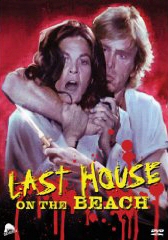
It's a rather ironic testimony to the paradoxical whim of human nature that audiences enjoy being frightened. An unconscious agent of the status quo, many horror movies end up reaffirming the very cultural taboos and conventions that their plots and hoary monsters 'externally' threaten. The vicious Outsider, be he beast or neighbour next door, usually wreaks havoc only to be defeated by the end credits. This reassures the audience, purging them. Less often do we allow characters to wallow in the nihilism of unrestrained realism, seeking to disturb not coddle. Admittedly, much of the art and entertainment of the horror movie is its fundamental escapism, tempering true terror and repulsion through fantastical subjects removed far enough from reality that we can sigh and say "hey, its only a movie." But there is another breed of film, one devoted to the depressing state of our charnel house condition. As I've pointed out in discussions of Henry or The Witch Who Came In From The Sea, these pictures seek to make no friends or converts. Their business is to grab you by your neck and throttle you. Merciless pain and a murderously dark depiction of humankind is their palate, and they spill blood and semen on our canvas of law and love and justice. The Last House on the Beach is such a mean spirited poem to nihilism. Wes Craven's seminal bad boy of the seventies The Last House on the Left inspired several European rip offs. Along with Aldo Lado's The Night Train, Franco Prosperi's suspenseful and tautly directed mind rape is one of the few successful imitators, using Craven's cold hearted and realistically portrayed animalism as a general template but finding its own identity. Brought to DVD by the scary folks at Severin, this European oddity has been restored and is featured uncut, daring you to witness its repugnant power.
The story, nasty and satisfying, is admittedly bleak. Often, so is life. And this is where mainstream fans of cinematic drivel sponsored by Coca Cola have the safety net ripped out from under them. There is little if anything depicted in this film that couldn't (indeed, probably has) happened in everyday life. It is this focus on the realistic that makes the story as grim and honest as it certainly is. It is also one of the chief reasons why it disgusts and angers so many critics. Merging the psycho sexual thriller convention with nunsploitation, writers Ettore Sanzo and Romano Miglioni are careful to never lose focus of the human misery so crucial to the plot, dwelling more on the properties of pain and fate than on popcorn entertainment. When Ray Lovelock, the leader of a gang of bank robbers botches a job, they go into hiding at an isolated beachside. Invading a seaside villa, they discover five teenage girls and their nun/teacher (played with aplomb by genre veteran Florinda Bolkan). It doesn't take long for things to get nasty. Before you can scream 'video nasty,' the girls are imprisoned in the house by Aldo, Walter, and Nino. A grim nightmare of sexual assault, humiliation, and bloodthirsty revenge ensues in amoral fashion.
This film treats violence as stupid and brutal and the last resort of the vicious, not glorified as so many critics so often mistakenly claim. The humiliation in this film isn't treated like an artful portrait or poem, as is often the approach employed by directors of the Slahser and Giallo. There is, in fact, nothing beautiful about death here. The atrocities, when they occur (often!) don't titillate or wow us with FX technical wizardry, having the guts and intelligence to smear it in our face instead. Violence IS horrible. Violence IS chaotic and painful and shocking and upsetting. And it is captured here in a slow-mo, non dramatic fashion that intensifies dread and disgust with our species. Such themes as social warfare, sexual tension, and the ever-changing line between victim and victimizer are stressed amidst the heart-sickening degradation. Similar to Craven's House and The Hills Have Eyes, as well as such pictures as Thriller and I Spit On Your Grave, Prosperi focuses on the age old archetype of the innocent or civilized character becoming what he hates to protect oneself. This central theme revolves around Cristina, a nun, who is constantly provoked. Angry and unrepentant in its depiction of humanity, Prosperi's scathing vivisection of morality is just as capable of offending and shocking today as it was in 1978. The Last House on the Beach manages to be upsetting and fascinating, artistic yet crass. While there is undeniably much for the exploitation junkie to groove to, the conventions of rape/revenge films are lent poetic and carefully measured direction by Prosperi, who coaxes believable and strangely touching performances by Bolkan and Lovelock while crowding the frame with mounting claustrophobia. Of further interest is the restraint when it comes to graphic violence. The most disturbing scenes are suggested rather than lingered over, with even the rape scene emphasizing the pain of the victim's face, not sexual organs. An uncompromising effort!
Also referred to as Terror, this flick has been treated haphazardly at best by numerous grey market copies that have shorn it of both quality and content. Severin Films presents Last House On The Beach uncut in an anamorphic widescreen of 2.35:1. The transfer is wonderful, lacking blemishes or grain, and colors are realistic and clean. Dolby Surround Mono offers equal distribution between sound and dialogue without any noticeable background interference.
Extras include "Holy Beauty vs. The Evil Beasts," a thoughtful 30-minute interview with star Ray Lovelock, who provides context for both the film and career, reviewing his experiences on the feature, his co-stars, and how he got his name. The only other supplements are German and Italian Theatrical Trailers.
Review by William Simmons
| Released by Severin |
| Region 1 - NTSC |
| Not Rated |
| Extras : |
| see main review |